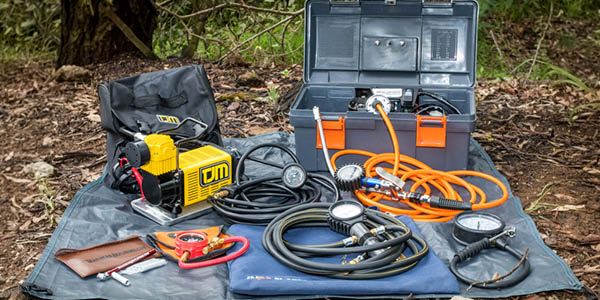Article originally by Unsealed 4X4
- Don’t be lazy – you’ll regret it
I’m sure all of us have done it. Not deflated our tyres when we really needed to and then proceeded to get bogged. The trick here is that if you start to feel like you are getting bogged, don’t spin the tyres faster. Stop, get out, let the tyres down to around 18psi for sand, reverse a metre or so, then try and drive forward. This will normally do the trick and get you through that soft sand.
- Find shade
Deflating or inflating your tyres in the blazing sun is definitely not fun. Find some shade and get your pressures right. It will take you some time so have a cool drink.
- Know what pressures are best
Understand what works for your particular vehicle and tyres in different terrain. A general rule of thumb is that 28psi is good for gravel, rocks and corrugations. Sand is generally best tackled with around 18psi. Lower tyre pressures mean that you will have to drive more slowly and make less-aggressive turns. Tyres with lower tyre pressures will behave differently and you may roll the tyres off the rims if turning too sharply. Be aware that if you lower the tyre pressures, you need to increase them again before driving on the bitumen.
- A stick will work
Although not ideal, you are able to deflate your tyres with a stick. Cheap and easy – but you need a gauge to know what pressure you have deflated them to. Eyeballing your tyres to work out what pressures they hold could be dangerous. Seeing as how you need to have a tyre gauge anyway, you can use that to deflate the tyres.
- Rapid tyre deflators
These are by far the quickest way to let air out of tyres. A tyre deflator works by attaching it to the valve stem, then unscrewing the tyre’s valve. With the valve displaced, a huge amount of air can be released quickly. The downside is that you need to be kneeling next to each of the four tyres as you let them down. If you buy the cheapest rapid tyre deflator, there is a chance that it could take twice as long as a reputable brand (and not be much quicker than a stick).
- Set pressure deflators
There are a couple of brands available; and they normally come in packs of four. These can be set at specific pressures (e.g. 18psi), attached to the valve stems, then left to automatically deflate the tyres. They will stop at the set pressures and four tyres can be deflated at once. Although each individual unit takes a bit longer than some other methods, the overall time will probably be the quickest for four tyres. And you don’t have to be kneeling down next to each tyre for the entire time.
- Two tyres at once
A relatively new piece of kit in the Australian market is the InDeflate which can inflate or deflate two tyres at once. The beauty of the InDeflate is that you can attach it to two tyres at once, then start deflating and watch the gauge to know when to stop. Both tyres will be at the same pressure and there’s no kneeling down required while it’s happening. Now here is the best bit: It can also inflate two tyres at once (with no kneeling). Although not cheap, this feature prised my wallet open to buy one. It’s particularly good for when I’m towing a trailer.
- You will need a compressor
If you are going 4WDing, you should have a compressor as part of your recovery kit. Waiting in line at a service station to inflate your tyres to road pressures is not fun (even if you can find one with a compressor that works). Having your own compressor allows you to inflate you tyres whenever you need to. There are many compressors available on the market. I was using a TJM unit which allowed me to screw the compressor hose onto the valve stem and walk away while a tyre was inflating. The other compressor I had was an ARB which required me to kneel down at each tyre for the duration of the inflation cycle. The TJM compressor screwed directly onto the InDeflate; while the ARB required an additional attachment.
- Find something that works for you
Many of you will already have compressors and gauges; some will not. If you already have some kit, have a think about whether your current setup is too much hassle. If it is, perhaps look at what extra gear will make it less of a hassle. If you don’t already have any of this stuff, check out the prices of each solution. You may need to buy a piece at a time to build up to the ultimate tyre pressure management kit for you.


